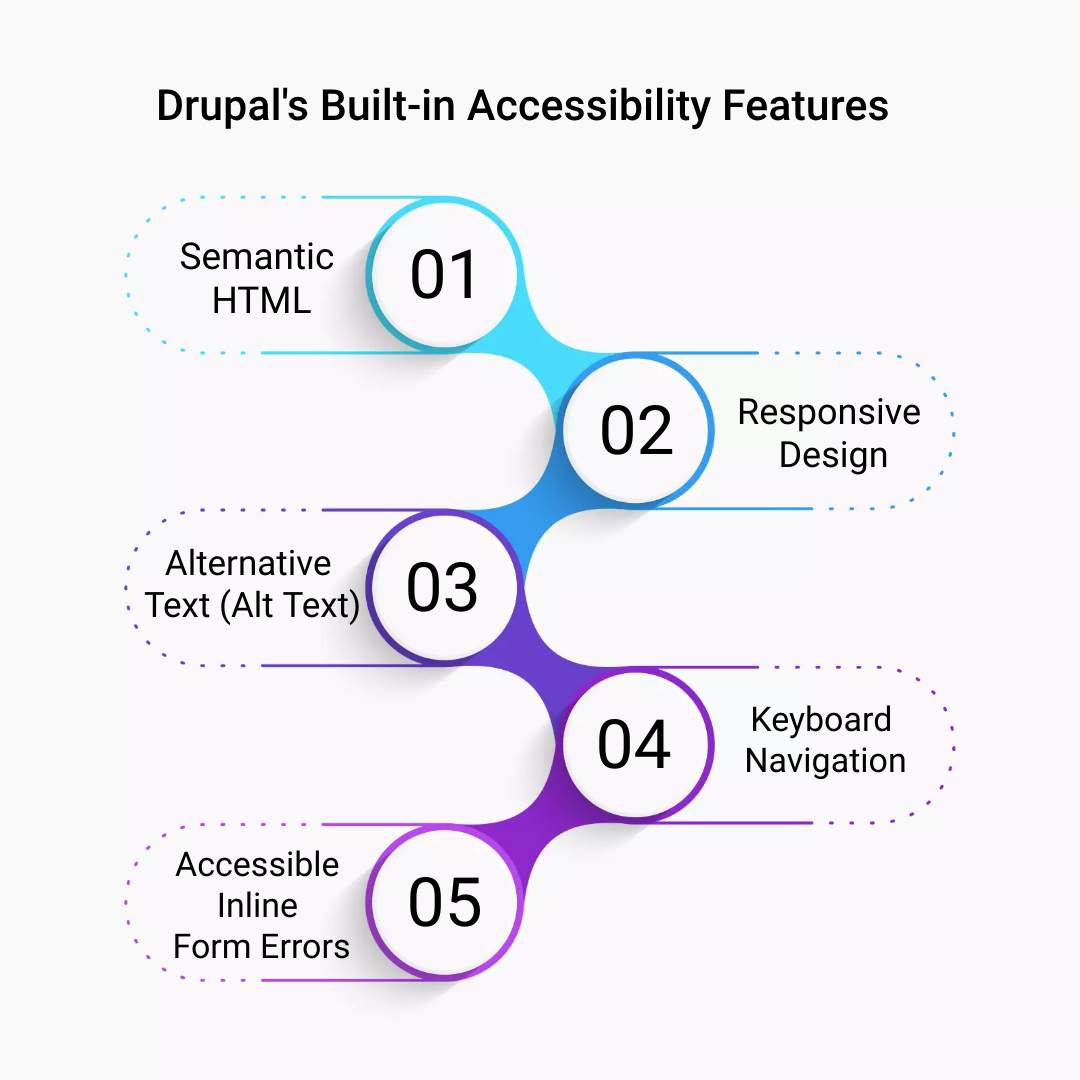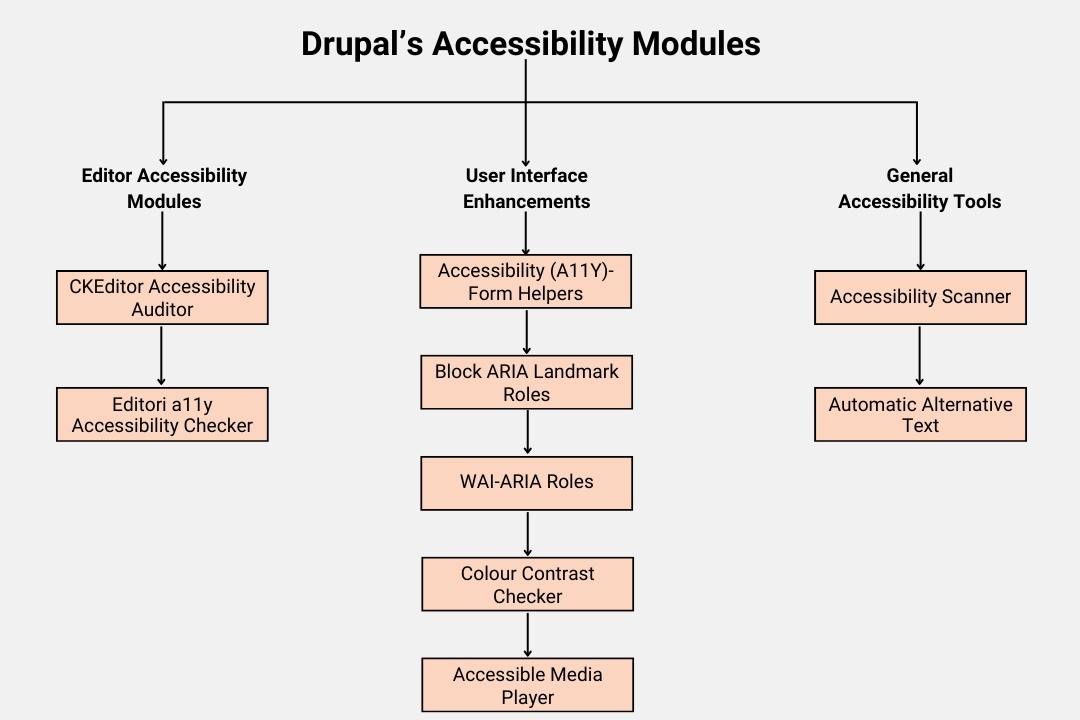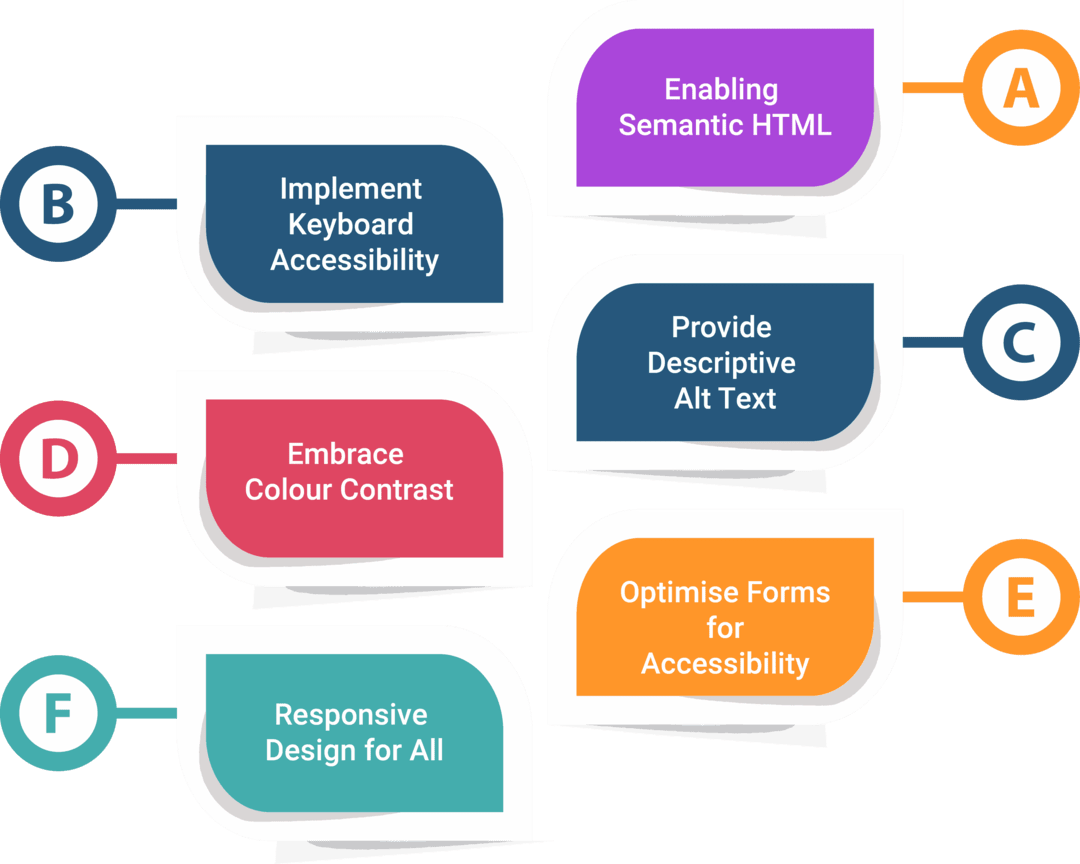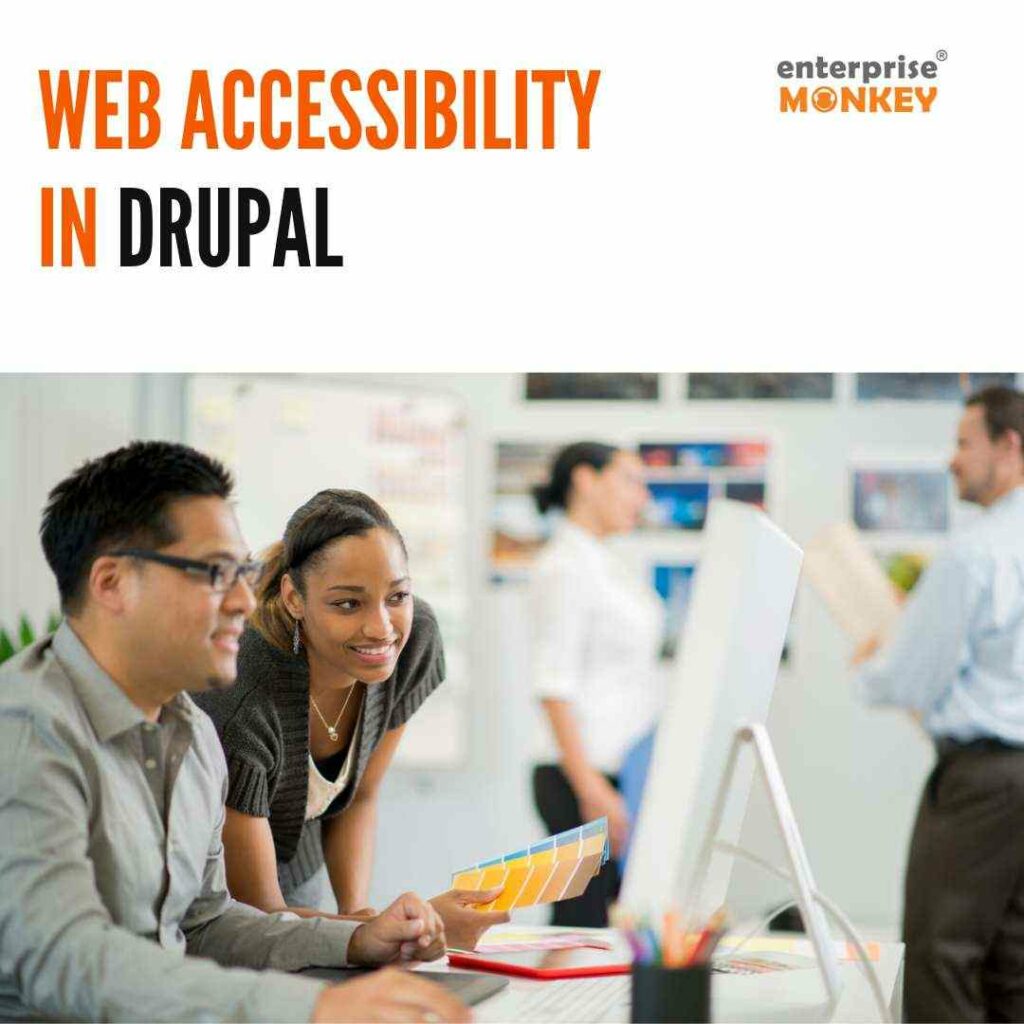The World Health Organisation (WHO) study reveals that 1 in every 6 people is disabled in some form or the other. This means 16% of the world population may be directly impacted if you make an inaccessible website for your business.
Therefore, web accessibility has become a critical aspect of modern web development, ensuring that websites are usable and inclusive for all users, including those with disabilities.
In the context of content management systems (CMS), Drupal stands out as a powerful platform that empowers developers to create accessible websites by providing them with robust tools and features.
For Drupal users, this translates to building websites that cater to a diverse range of users, regardless of their abilities. It means you have the power to build a website that is accessible to every individual and perfectly meets the standards of Web Content Accessibility Guidelines (WCAG).
In this blog, we’ll delve into the world of Web Accessibility in Drupal, exploring the platform’s built-in features, powerful modules, and the overall impact of creating inclusive online experiences.
We’ll explore the importance of web accessibility in Drupal and outline essential strategies and best practices to ensure that your website is accessible and user-friendly for everyone. But let’s first understand more about web accessibility. Stay tuned!
What is Web Accessibility?
Web accessibility refers to the practice of designing and developing websites and web applications to ensure they are usable and accessible to people of all abilities, including those with disabilities.
A website is considered accessible by making content perceivable, operable, understandable, and robust for users, regardless of their physical or cognitive capabilities.
Therefore, the Key Principles of Web Accessibility given by WCAG includes:

- Perceivable: Information and user interface components must be presentable to users in ways they perceive. This includes providing text alternatives for non-text content, ensuring sufficient colour contrast, and making multimedia content accessible.
- Operable: Users should be able to navigate and interact with the website using various input methods, such as keyboard navigation and voice commands. Interactive elements should be accessible and manageable by all users, including those with motor disabilities.
- Understandable: The content and operation of the website should be clear and easy to understand. This involves using plain language, providing clear instructions and error messages, and ensuring consistent navigation.
- Robust: The website should be compatible with a wide range of user agents, including assistive technologies such as screen readers and braille devices. This ensures that users can access the content regardless of the technology they use.
Web accessibility involves adhering to standards and guidelines, such as the Web Content Accessibility Guidelines (WCAG), to ensure that websites are inclusive and can be accessed by everyone, regardless of their abilities or the devices they use.
Importance of Web Accessibility
Web accessibility is critical for every website owner as it leads to wider audience reach, improved SEO, and a positive brand reputation. Below are the importance of web accessibility:

- Increased Audience Reach: Accessible websites cater to a wider range of users, including those with disabilities. This expands your potential user base and increases website traffic.
- Improved SEO: Search engines consider accessibility when ranking websites. Accessible websites tend to rank higher in search results.
- Enhanced User Experience: Everyone deserves a positive browsing experience. Accessible websites are easier to navigate and understand for all users.
- Reduced Legal Risk: Web accessibility regulations exist. Following them helps you avoid potential lawsuits.
- Stronger Brand Reputation: Building an inclusive website shows that you value your users and their needs. This fosters trust and loyalty.
Web Accessibility in Drupal
Drupal, being a popular and powerful content management system (CMS), offers a range of tools, modules, and features specifically aimed at promoting web accessibility.
The accessibility features were in the introductory stage in Drupal 7. However, with the advent of Drupal 8 in 2015, web accessibility remained at the top priority. With the Drupal 9 update, the software has significantly started, including accessibility.
Now, Drupal core provides built-in features and guidelines that developers can follow to ensure their websites meet the WCAG 2.1 , 2.2 and 3 requirements—for example, providing alternative text for images, creating semantic HTML structures, implementing keyboard navigation support, and ensuring colour contrast for readability.
Drupal’s Built-in Accessibility Features
Drupal provides a robust set of built-in features that pave the way for creating accessible websites. These features are included in the core software of Drupal, focusing on making your website usable for everyone, regardless of their abilities.
Some of the key accessibility features built into Drupal include:

-
Semantic HTML
Drupal utilises clean and semantic HTML markup by default to structure your website’s content. This means it uses HTML elements that clearly define the meaning and purpose of each section, like headers (<h1> to <h6>), paragraphs (<p>), and navigation elements (<nav>).
This structure is crucial for assistive technologies like screen readers to understand the webpage layout and present the information effectively so that users can interpret it accurately. -
Responsive Design
Drupal themes are responsive, meaning they ensure that their page layout fits different screen sizes and devices. This caters to users who rely on mobile devices or assistive technologies with specific display requirements.
For example, a website that utilises responsive design will ensure proper formatting and easy navigation on a small phone screen as well as a large desktop monitor. -
Alternative Text (Alt Text)
Drupal prompts content creators to provide descriptive alternative text (alt text) for images. Alt text is crucial for users who are visually impaired and rely on screen readers to understand the content.
A well-written alt-text description accurately conveys the message or purpose of the image, ensuring that everyone has access to the entire website experience. -
Keyboard Navigation
A core tenet of web accessibility is ensuring users can navigate the website entirely using just a keyboard. Drupal addresses this by allowing complete website navigation through keyboard controls. This is particularly important for users who cannot use a mouse or have motor limitations that make mouse navigation difficult.
-
Accessible Inline Form Errors
Drupal forms provide clear and accessible error messages when a user submits invalid data. These error messages are positioned close to the corresponding form field, making it easy for users to identify and rectify any mistakes. This ensures a smooth user experience during form interactions.
These built-in features, along with Drupal’s vast ecosystem of accessibility modules, empower you to create inclusive websites that cater to a diverse range of users.
Drupal’s Accessibility Modules
Drupal’s core provides a solid foundation for accessibility, but the true power lies in its extensive community and the wealth of accessibility modules it contributes.
Drupal latest version 9.4 and Drupal 10 offers extensive built-in features and modules to make your website extremely functional and accessible, keeping in mind the usage pattern of every user, even those with significant disabilities.
These modules address various needs and can substantially enhance the usability of your Drupal website. Let us take a glimpse at some popular Drupal accessibility modules:

Editor Accessibility Modules
- CKEditor Accessibility Auditor: This module scans content created in the CKEditor for accessibility issues. It identifies potential problems and offers suggestions for improvement, helping content creators ensure their work adheres to accessibility guidelines.
- Editori A11y Accessibility Checker: This module works similarly to the CKEditor auditor but functions within the editor. It provides a real-time accessibility check, highlighting potential issues as content is created.
User Interface Enhancements
- Accessibility (A11Y)-Form Helpers: This module tackles accessibility (A11y) challenges within Drupal forms. It ensures forms are built with accessibility in mind, including features like proper labelling and keyboard navigation compatibility.
- Block ARIA Landmark Roles: This module improves the navigation experience for screen reader users by assigning ARIA (Accessible Rich Internet Applications) landmark roles and labels to blocks on your website. These labels provide clear context about the purpose and location of each block, making it easier for users to navigate the page structure.
- WAI-ARIA Roles: This module extends Drupal’s support for WAI-ARIA (Web Accessibility Initiative – Accessible Rich Internet Applications) roles and attributes, allowing developers to add semantic information to web elements for better accessibility, especially for dynamic and interactive content.
- Colour Contrast Checker: The Colour Contrast Checker module helps site administrators and designers ensure that text and background colours meet WCAG (Web Content Accessibility Guidelines) requirements for colour contrast, which is crucial for readability and accessibility, especially for users with visual impairments.
- Accessible Media Player: This module integrates an accessible media player into Drupal websites, ensuring that audio and video content is playable and navigable for users with disabilities, including keyboard controls, captions, and audio descriptions.
General Accessibility Tools
- Accessibility Scanner: This module integrates Deque’s Axe accessibility testing tool within the Drupal interface. It allows you to run accessibility scans on your website directly from your Drupal dashboard, identifying potential issues and streamlining the accessibility auditing process.
- Automatic Alternative Text: This module leverages Microsoft Azure Cognitive Services to automatically generate alternative text descriptions for images. While not a substitute for human-written descriptions, it provides a good starting point and saves time, especially for websites with a large number of images.
Best Practices to Improve Drupal’s Website Accessibility
A more accessible website benefits not only users with disabilities but also enhances the overall user experience for everyone.
By following the tips below and leveraging Drupal’s built-in features and accessibility modules, you can create a website that is inclusive, user-friendly, and accessible to all:
| If you are hiring a professional Drupal development agency, discuss with them about the cost of Drupal website development and additional pricings to make it accessible. This information will help you create your business’s high-end website, while being on budget. |

Enabling Semantic HTML
Enabling semantic HTML is crucial to improving website accessibility in Drupal and beyond. Semantic HTML refers to using HTML elements that convey content’s meaning and structure.
It makes the website more accessible for users and assistive technologies (like screen readers) to interpret and navigate effectively.
| Steps to Enable HTML Markup | |
| 1. Choose a Semantic HTML Theme | Drupal core doesn’t enforce semantic HTML by default. You can choose a theme specifically designed with semantic markup. Popular options include Bartik and Olivero. |
| 2. Enable the Semantic Views Module (Optional) | This module (compatible with Drupal 8, 9 and later versions) allows you to define semantic HTML elements directly within the Views UI, simplifying the process for content editors. |
| 3. Validate Your Semantic HTML | There are online tools and browser developer extensions available to validate your website’s code and ensure it adheres to semantic HTML standards. |
Unlike generic HTML tags (<div> or <span>), semantic HTML uses specific tags that clearly define the meaning and purpose of each content section. This is akin to speaking clear and concise language.
For instance, using a <h1> tag for a main heading or <p> for a paragraph tells assistive technologies like screen readers precisely what that content is.
Implement Keyboard Accessibility
Implementing keyboard accessibility ensures that users can navigate, interact with, and operate all elements of the website using only the keyboard, without relying on a mouse or other pointing device.
| Keyboard accessibility is essential for users with motor disabilities, mobility impairments, or those who prefer keyboard navigation for efficiency and convenience.
Imagine navigating a website entirely with just a keyboard; that’s the reality for many users with motor limitations or who cannot use a mouse. |
By ensuring that interactive elements such as links, buttons, form fields, and menus can be accessed and activated using keyboard shortcuts, Drupal websites become more inclusive and usable for all users.
This best practice involves following WCAG guidelines for keyboard accessibility, managing focus states effectively, providing keyboard-friendly navigation structures, and ensuring that interactive elements are reachable and operable via keyboard input.
Provide Descriptive Alt Text
Descriptive alt text acts as a bridge to users who may not be able to see them, such as screen reader users or users with visual impairments. It provides clear and concise textual descriptions of what each image conveys.
For instance, an alt text for an image of a product might be “Red rose bouquet in a glass vase” or “Close-up photo of a chef preparing a dish.”
Importance of Descriptive Alt Text:
|
How to Add Alt Text in Drupal:
- Navigate to the “Manage fields” section for the content type where you upload images.
- Locate the “Image” field and ensure the “Enable alt field” and “Alt field required” options are checked.
- When adding or editing an image, you’ll see an “Alt text” field where you can enter a descriptive text for the image.
Therefore, by providing descriptive alt text that accurately describes the content of the image, Drupal websites ensure that all users can access and comprehend the information presented visually.
Embrace Colour Contrast
Focusing on colour contrast is another crucial element in establishing the accessibility of your Drupal website. It ensures that text and visual elements are distinguishable and readable for all users, including those with low vision or colour vision deficiencies.
By adhering to WCAG guidelines, Drupal offers tools to check colour contrast ratios and recommends a minimum ratio of 4.5:1 for standard text and 3:1 for large text.
Colour Contrast Recommendations:
|
Ensuring an adequate colour contrast and a clear distinction between foreground text and its background, improves legibility and reduces eye strain, making content more accessible and easily comprehended.
Therefore, this practice involves choosing colour combinations that meet or exceed WCAG’s contrast requirements, testing colour contrast using accessibility tools, and maintaining consistency in colour usage throughout the website.
Optimise Forms for Accessibility
Forms are interactive elements that users often rely on to input information, submit requests, or complete transactions. By optimising forms for accessibility, you ensure everyone can easily understand, complete, and submit them.
Thus, an inaccessible form may contain issues such as:
- Missing Labels: Users, especially those relying on screen readers, need clear labels to understand the purpose of each form field.
- Unclear Instructions: Confusing instructions can lead to errors and frustration.
- Lack of Keyboard Navigation: Users with motor limitations should be able to navigate the form using just the keyboard.
- Insufficient Colour Contrast: Poor colour contrast between text and background makes it difficult for users with visual impairments to read the form.
Drupal offers built-in modules, like A11Y: Form Helpers Module and Web Form Accessibility Module, specifically designed to enhance form accessibility.
These modules are typically installed through the Drupal user interface. Once installed, they work seamlessly in the background, automatically applying accessibility best practices to your Drupal forms.
Responsive Design for All
Implementing responsive design is a cornerstone best practice for building accessible Drupal websites. Responsive design ensures your website adapts seamlessly to different screen sizes and devices, catering to a wider range of users.
This inclusivity is essential for users with disabilities who may rely on specific devices or assistive technologies with unique display requirements.
Achieving Responsive Design using Drupal Core Functionalities and Modules:
|
Responsive design improves accessibility by optimising content readability, navigation, and interaction, regardless of the device or platform used by the user.
For instance, it ensures the website layout and functionalities remain clear and easy to navigate on a small smartphone screen as well as a large desktop monitor.
Why You Should Not Ignore Accessibility?
Ignoring web accessibility can have significant consequences that impact both users and organisations. From a user perspective, it leads to exclusion and frustration.
From a business point of view, ignoring web accessibility can impact revenue generation and brand loyalty. Additionally, inaccessible websites may perform poorly in search engine rankings, affecting organic traffic and online visibility.
Let us see the consequences of ignoring the web accessibility perspective:
-
Exclusion of Users
Ignoring web accessibility means excluding users with disabilities from accessing and using your website effectively. This can lead to frustration, discrimination, and a lack of equal opportunities for participation in digital spaces.
-
Legal Consequences
Ignoring web accessibility can result in serious legal issues, especially in countries like Australia that have stringent laws and regulations concerning digital accessibility.
In Australia, the Disability Discrimination Act (DDA) of 1992 mandates that organisations ensure their digital platforms, including websites and mobile applications, are accessible to people with disabilities. Failure to comply with these accessibility standards can lead to legal consequences.
If found guilty of violating the DDA, organisations may be required to take remedial actions, such as making their website accessible, providing alternative formats of content, and ensuring ongoing compliance with Web Content Accessibility Guidelines (WCAG).
Financial penalties are another potential consequence of ignoring web accessibility. -
Poor User Experience
Inaccessible websites often provide a poor user experience for all users, not just those with disabilities. This can lead to decreased user satisfaction, higher bounce rates, and reduced engagement and conversions.
-
Negative Reputation
Ignoring web accessibility reflects poorly on an organisation’s commitment to inclusivity and social responsibility. It can damage the organisation’s reputation, leading to lost trust and credibility among customers, clients, and stakeholders.
Conclusion
Web accessibility is not just a legal requirement but also a moral imperative to ensure everyone can access and benefit from online content.
Drupal, with its emphasis on accessibility and user experience, provides developers with the tools and resources needed to create accessible websites and contribute to a more inclusive web ecosystem.
Therefore, by hiring an expert Drupal website development company for your project and following best practices, you can stay informed about accessibility guidelines, impact digital inclusion and ensure user satisfaction.













